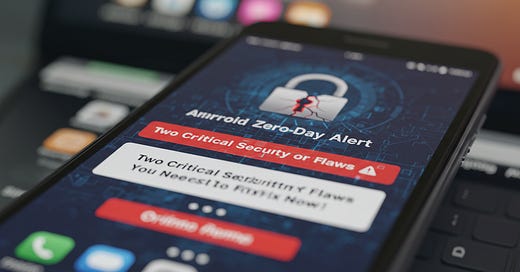Android Zero-Day Alert: Two Critical Security Flaws You Need to Fix Now
Your Android device may be at risk—here’s what you need to know.
Why This Matters
Two newly discovered Android security flaws, CVE-2024-43093 and CVE-2024-50302, have been actively exploited before a fix was available. These vulnerabilities allow attackers to bypass security protections, access sensitive files, and even unlock a phone’s core functions. Google has issued patches, but if your device isn’t updated, you remain exposed to potential cyber threats.
What Happened?
Two serious vulnerabilities were found within Android’s security framework:
CVE-2024-43093 – Android File Access Bug: A flaw in how Android processes special characters in file names allowed malicious apps to access restricted system folders, potentially exposing personal data.
CVE-2024-50302 – Android Kernel Bug: A security hole in the Linux kernel, which powers Android, made it possible for attackers to extract sensitive data from the system’s memory—potentially leading to device unlocking and spyware installation.
Both vulnerabilities were exploited in targeted attacks before Google was able to release fixes, making them classified as “zero-day” threats—meaning hackers were already using them before anyone knew they existed.
How These Attacks Work
Understanding how attackers can exploit these flaws helps you stay protected.
CVE-2024-43093 – The File Access Bug
A hacker tricks you into installing a seemingly harmless app.
The malicious app exploits the flaw to access protected system files.
Sensitive data is exposed, potentially leading to identity theft or unauthorized system modifications.
CVE-2024-50302 – The Kernel Memory Leak
This exploit requires either physical access or a USB connection to your device.
An attacker, law enforcement agency, or forensic investigator can use special tools to exploit this vulnerability.
Once executed, the attack grants unauthorized access to your device’s memory, allowing for lock screen bypassing and potential spyware installation.
A real-world example of this attack occurred in Serbia, where authorities reportedly used forensic tools to unlock and install spyware on a confiscated Android phone.
How to Protect Yourself
Protecting yourself against these vulnerabilities is straightforward—if you take action now.
1. Update Your Device Immediately
Google has released security patches in its March 2025 update to fix these flaws. To update your device:
Go to Settings > About phone > Software update (varies by manufacturer).
Check for updates and install the latest version.
Restart your phone to apply the security patch.
2. Verify Your Security Patch Level
Once updated, ensure your device has the latest security fixes:
Go to Settings > About phone > Android version > Security patch level.
Look for March 5, 2025, or later—if your device shows an older date, it may not have received the update yet.
3. Check If Your Device Is Still Supported
Not all Android devices will receive updates. If your phone is more than 3 years old, it may no longer get security patches, leaving it vulnerable to these and future exploits. If your device is outdated, consider upgrading or using extra security precautions.
4. Use a Mobile Security App
A trusted mobile security app can:
Detect and block malware trying to exploit CVE-2024-43093.
Provide real-time protection against malicious downloads and phishing attempts.
Alert you if your device settings are insecure.
Recommended options include Malwarebytes, Bitdefender, Norton, and Avast.
5. Avoid Sketchy Apps and Links
Only download apps from Google Play Store.
Be cautious of permissions—an app asking for excessive access is a red flag.
Avoid clicking on suspicious links in emails, messages, or websites.
6. Secure Your Device Physically
Since CVE-2024-50302 can be exploited via USB connections:
Use a strong PIN, password, or biometric lock.
Don’t leave your phone unattended in public places.
Enable USB debugging protection in developer settings to prevent unauthorized access.
What Stands Out About This Update
Google’s rapid response and commitment to patching these zero-days underscore the importance of staying up to date. Their ability to fix vulnerabilities before widespread exploitation is crucial in keeping Android users safe.
Take Action Now
Cybersecurity threats are always evolving, and timely updates are your best defense. If you haven’t checked for updates recently, do it now. Staying informed and proactive ensures your device remains secure against emerging threats.
Get your free personal cybersecurity & privacy assessment here
Stay secure, stay confident—CyberLife Coach is here to guide you every step of the way!




